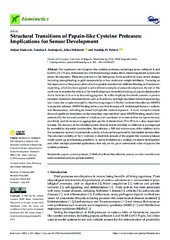| dc.creator | Marković, Srdjan | |
| dc.creator | Andrejević, Natalija S. | |
| dc.creator | Milošević, Jelica | |
| dc.creator | Polović, Natalija | |
| dc.date.accessioned | 2023-12-06T10:09:08Z | |
| dc.date.available | 2023-12-06T10:09:08Z | |
| dc.date.issued | 2023 | |
| dc.identifier.issn | 2313-7673 | |
| dc.identifier.uri | http://cherry.chem.bg.ac.rs/handle/123456789/6289 | |
| dc.description.abstract | The significant role of papain-like cysteine proteases, including papain, cathepsin L and SARS-CoV-2 PLpro, in biomedicine and biotechnology makes them interesting model systems for sensor development. These enzymes have a free thiol group that is suitable for many sensor designs including strong binding to gold nanoparticles or low-molecular-weight inhibitors. Focusing on the importance of the preservation of native protein structure for inhibitor-binding and molecular-imprinting, which has been applied in some efficient examples of sensor development, the aim of this work was to examine the effects of the free-thiol-group’s reversible blocking on papain denaturation that is the basis of its activity loss and aggregation. To utilize biophysical methods common in protein structural transitions characterization, such as fluorimetry and high-resolution infrared spectroscopy, low-molecular-weight electrophilic thiol blocking reagent S-Methyl methanethiosulfonate (MMTS) was used in solution. MMTS binding led to a two-fold increase in 8-Anilinonaphthalene-1-sulfonic acid fluorescence, indicating increased hydrophobic residue exposure. A more in-depth analysis showed significant transitions on the secondary structure level upon MMTS binding, mostly characterized by the lowered content of α-helices and unordered structures (either for approximately one third), and the increase in aggregation-specific β-sheets (from 25 to 52%) in a dose-dependant manner. The recovery of this inhibited protein showed that reversibility of inhibition is accompanied by reversibility of protein denaturation. Nevertheless, a 100-fold molar excess of the inhibitor led to the incomplete recovery of proteolytic activity, which can be explained by irreversible denaturation. The structural stability of the C-terminal β-sheet rich domain of the papain-like cysteine protease family opens up an interesting possibility to use its foldamers as a strategy for sensor development and other multiple potential applications that rely on the great commercial value of papain-like cysteine proteases. | |
| dc.language | en | |
| dc.publisher | MDPI | |
| dc.relation | info:eu-repo/grantAgreement/MESTD/inst-2020/200168/RS// | |
| dc.rights | openAccess | |
| dc.rights.uri | https://creativecommons.org/licenses/by/4.0/ | |
| dc.source | Biomimetics | |
| dc.subject | conformational analysis | |
| dc.subject | covalent modification | |
| dc.subject | cystein protease | |
| dc.subject | papain | |
| dc.subject | protein stability | |
| dc.subject | S-Methyl methanethiosulfonate | |
| dc.subject | sensor | |
| dc.title | Structural Transitions of Papain-like Cysteine Proteases: Implications for Sensor Development | |
| dc.type | article | en |
| dc.rights.license | BY | |
| dc.citation.volume | 8 | |
| dc.citation.issue | 3 | |
| dc.citation.spage | 281 | |
| dc.identifier.doi | 10.3390/biomimetics8030281 | |
| dc.citation.rank | M21~ | |
| dc.type.version | publishedVersion | |
| dc.identifier.scopus | 2-s2.0-85166321712 | |
| dc.identifier.fulltext | http://cherry.chem.bg.ac.rs/bitstream/id/34387/Structural_Transitions_pub_2023.pdf | |


